Bulgaria—AR-M1 Bayonet
Knife bayonet for use with newly-manufactured Kalashnikov assault rifles supplied to the New Iraqi Army.
In 2004, Arsenal Co. began contracting with the U.S. Government to supply Kalashnikov rifles to equip the reconstituted New Iraqi Army. Arsenal Co. manufactures the 7.62 mm. AR–M1, which is a hybrid incorporating up-to-date AK74 design features, such as polymer furniture, with the more durable early milled receiver and front sight block. Arsenal Co. produced the AR–M1 bayonet for use with the milled receiver rifles, since they were also producing the AK74 bayonet for use with stamped receiver rifles. The black nylon web belt hanger is unique to the bayonets supplied to Iraq, with Bulgarian Army bayonets retaining the leather belt hanger.

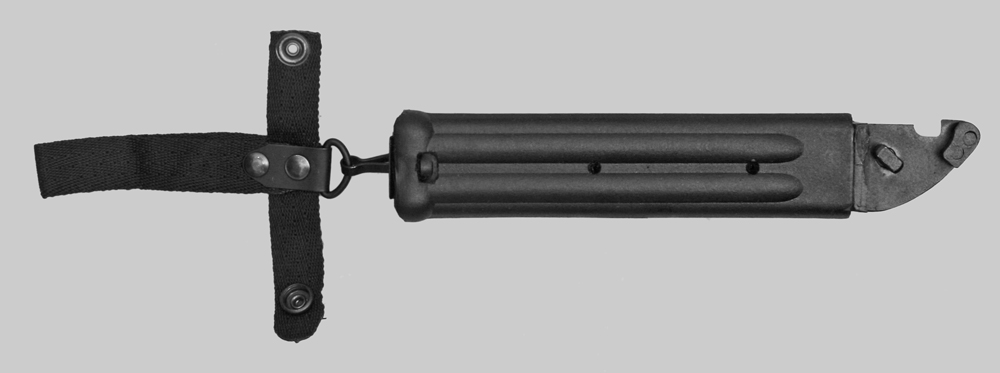
China—Type 56 Rifle Bayonet
The Chinese Type 56 rifle is a close copy of the AK47. The bayonet remains attached and folds under the barrel to stow in a cutout in the rifle's lower handguard. The Type 56 Rifle bayonet differs from the Type 56 Carbine (SKS clone) bayonet, in the absence of a muzzle ring. This is the bayonet observed on the AKs equipping the People's Liberation Army.

Three versions exist: a clamp-on version (with rings like a scope mount), a quick-detachable version, and a pinned-on version (pictured above).
China—Type 81 Bayonet
Although the Type 81 rifle borrows from the Type 56 Rifle (AK47), Type 56 Carbine (SKS), and Dragunov designs, it is a totally new rifle. As a result, the Type 81 bayonet will not mount to any other Kalashnikov rifle. Unlike the Chinese AK47 and AKM Type II bayonets that were manufactured solely for commercial sale, the Type 81 bayonet is used in quantity by the Peoples' Liberation Army (PLA).
The bayonet's red-brown polymer grip, double-fullered blade, and green plastic scabbard are distinctive and make for an attractive design. When these were first imported to the U.S. in the mid-2000s, they did not sell well. U.S. importer, Paragon Sales, modified some by bushing the muzzle ring and welding a plate to the pommel, enabling them to mount to the U.S. M1 Carbine. The Type 81 rifle was produced from ca. 1983 into the mid-1990s, as development of the Type 95 rifle neared completion. This example is of recent manufacture, produced for commercial sale.


China—Type 87 Bayonet
Knife bayonet for use with the 5.8 mm. QBZ-87 (Qing Buqiang Zu or, in English, Light Rifle Family 1987). The QBZ-87 rifle was to be an improved Type 81, but also introduced a new 5.8 x 42 mm. cartridge. The rifle was judged to not offer sufficient advantages over the Type 81 to merit its adoption.
The bayonet offers the wire cutter, sawback, and symmetrical blade profile of the Russian AK74 bayonet, along with a detachable belt hanger design similar to some GMS-produced KCB-77 bayonets. The hilt design is very similar to the Type 81 bayonet. The scabbard's wire-cutter design also includes a can-opener. Following a decision not to adopt the QBZ-87, the remaining bayonets were recalled and destroyed. Very few made it into private hands. Originals had the sawback on the lower blade edge and the scabbard had a green web belt hanger. This example with the sawback on the upper edge and scabbard with a tan belt hanger is a reproduction of recent manufacture, produced for commercial sale.


Czechoslovak Republic—VZ–58 Bayonet
The 7.62 mm. vz. 58 assault rifle (7,62 mm samopal vzor 58) outwardly resembles the AK47 in some respects, but is a unique design internally. The Czechoslovak Republic was the only Warsaw Pact nation that did not use the AK47 or AKM.
The Czechoslovak-designed bayonet shares a blade similar to that of the AK47 bayonet, but with a more conventional hilt. The VZ–58 bayonet was produced for more than 20 years. A surprising number of manufacturing variations have been observed. Early bayonets had a wood grip. A reddish-brown composition plastic grip was introduced in the early 1960s and is more common. Grips can be found with no exposed rivets or one, two, or three rivets. A lower crosspiece extension (finger guard) was introduced in the mid-1960s. The tang only extended part way into the grip until very late (early 1970s?), when the tang was extended beyond the composition grip (additional testimony that the soldier's compulsion to use the bayonet as a hammer is universal). The scabbard is leather with an integral belt loop. A vinyl scabbard also exists, but is uncommon.

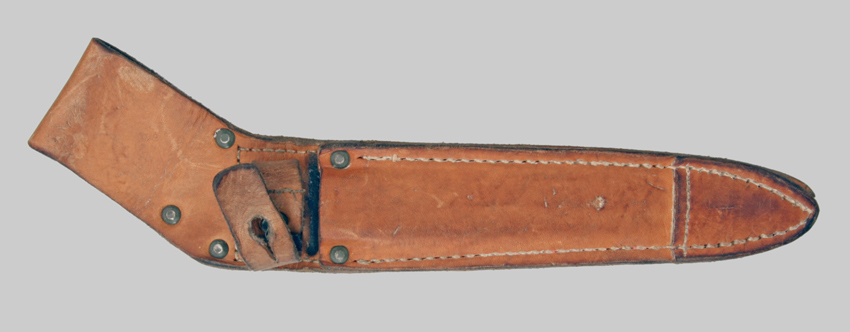
Go to the Czechoslovak VZ–58 bayonet page.
Finland—M1962 Bayonet
Knife bayonet for use with the Rynnäkkökivääri (assault rifle) 62 & 76 series produced by Valmet. The Rk62 and Rk76 series are generally accepted to be the most significant refinement of the Kalashnikov design, with improved internals and sights. Unlike ComBloc Kalashnikovs, Valmet rifles are manufactured with high attention to tolerances and finish, making them the Rolls-Royce of Kalashnikovs. Israel began with the Rk62, when designing the Galil.
The Finnish M1962 bayonet is patterned after the Czech VZ–58 bayonet. However, it is a simpler affair, with an unfullered blade and molded plastic grip scales. The press stud is oddly placed in the middle of the grip. The M1962 came with a factory edge, something unusual for bayonets. The scabbard is made of stiff green pebble-grained (reindeer?) leather, securely riveted together.


Germany—G36 Bayonet
Knife bayonet for use with the 5.56 mm. NATO caliber Heckler & Koch G36 assault rifle. This G36 bayonet was created in 1996 on a trial basis in an attempt to make use of the large stocks of former East German Modell 74 (AKM Type II) bayonets. The original muzzle-ring was cut away and a new, large diameter muzzle ring welded in place. The East German leather belt hanger was replaced by a complex web and plastic belt hanger designed to fit the West German load bearing equipment.
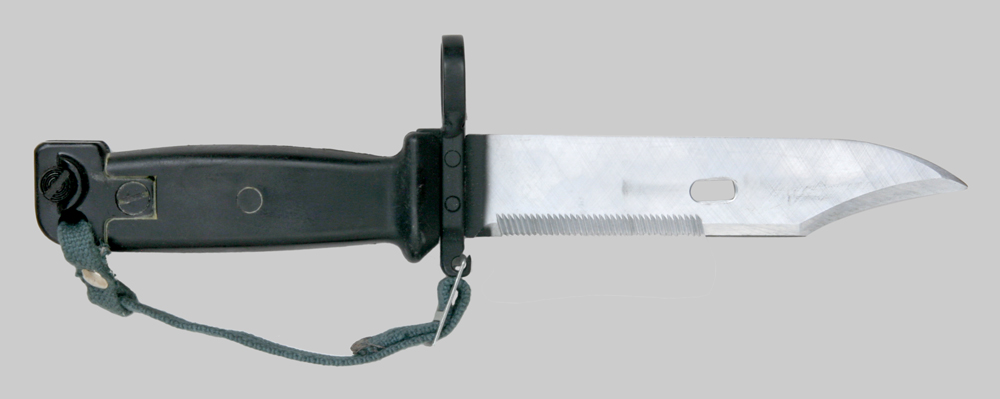
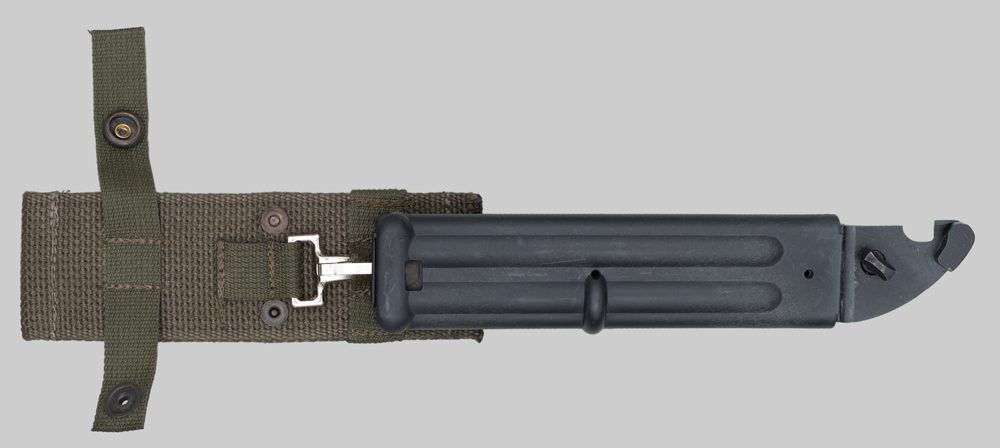
India—INSAS Bayonet
Knife bayonet for use with the 5.56 mm. NATO caliber INSAS (Indian Small Arms System) rifle. The INSAS bayonet is primarily patterned on the AKM Type II bayonet, but with a conventional edge-down blade profile and a pommel characteristic of its predecessor, the 1A bayonet. The NATO-spec 22 mm. muzzle ring terminates in a bizarre screwdriver-point finial. The scabbard's wire-cutter incorporates a pointed hook for use as a bottle opener. Production began in 1997 at Rifle Factory Ishapore (RFI). The fit and finish are rather poor, on a level with Egyptian AKM bayonets. A bit surprising, given RFIs long experience with bayonet production.
North Korea—Type 68 Bayonet
The North Korean Type 68 rifle was their copy of the Russian AKM design. The North Korean Type 68 bayonet is a hybrid, combining many features of the AK47 bayonet, with a pommel similar to the AKM Type II bayonet. The fullered clip-point blade profile is also a hybrid of the AK47 and AKM designs. The scabbard is very similar to the AK47 scabbard. Scabbards are encountered with both a green web belt hanger (pictured below) and a tan web belt hanger.

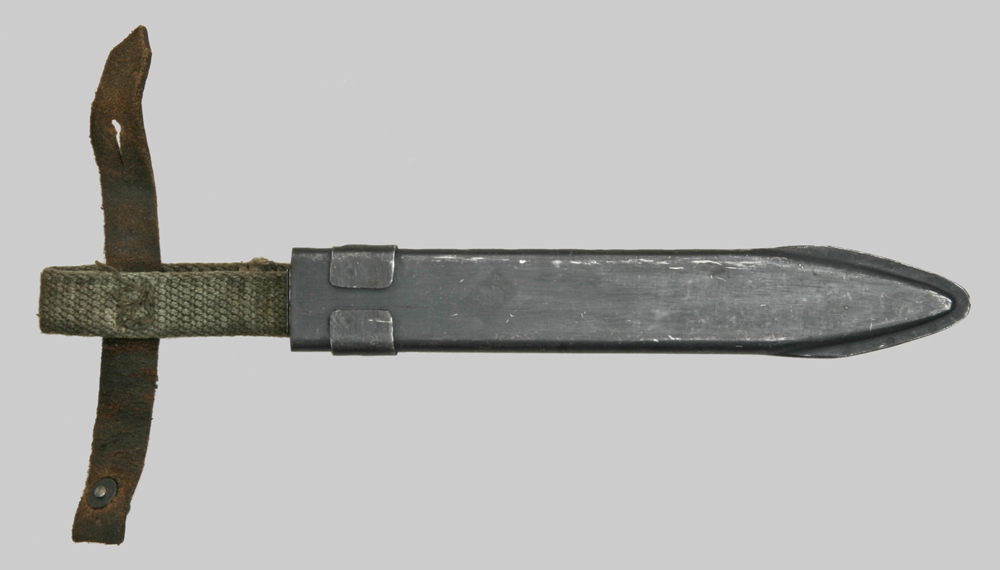
Poland—Wz85 Fencing Bayonet
Fencing bayonet utilizing the 6H4 (AKM Type II) hilt, mated to a spring-loaded rubber-pointed blade. The blade retracts when thrust against a fencing target and rebounds when withdrawn. The blade may also be retracted and secured by a sliding crossbolt for storage. Designated Wzór 85 (Model 1985), these were made by Fabryka Broni, Radom ca. 1985–88.
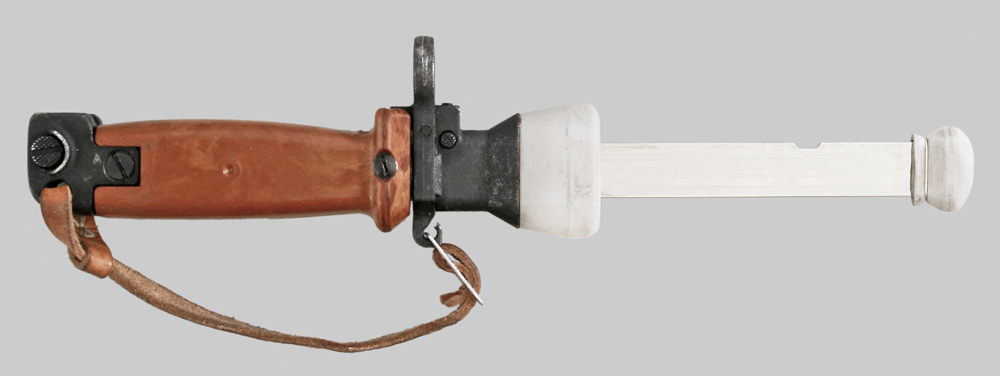
© Ralph E. Cobb 2010 All Rights Reserved





